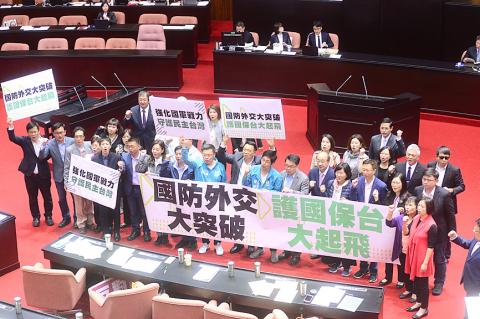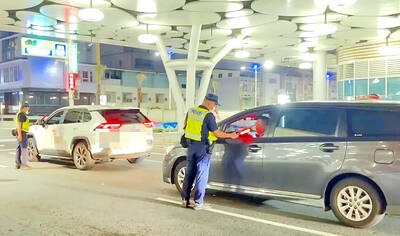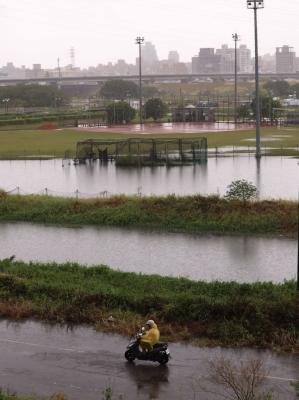Lawmakers yesterday approved a special budget of NT$247.2 billion (US$8.1 billion) for the procurement of 66 F-16V jets from the US.
Lawmakers reached a consensus on the final amount during cross-caucus talks, trimming NT$10 million from the logistical fees budget.
According to the Special Act on the Procurement of Updated Fighter Jets (新式戰機採購特別條例), passed in September, the procurement package covers the acquisition of the jets and their equipment, as well as the acquisition, maintenance, development and manufacture of ancillary systems.

Photo: Wang Yi-sung, Taipei Times
The fund would be drawn from loans and surplus revenue from the previous fiscal year, it says.
If the expenditure exceeds the approved budget due to currency fluctuations, an item should be proposed in the general budget to cover the shortfall, it says.
Several Democratic Progressive Party (DPP) lawmakers signed up to speak after the passage of the special budget.
The procurement plan for new US fighter jets was the first since 1992, after the nation’s two bids in 2000 and 2008 were rejected by Washington, DPP Legislator Tsai Shih-ying (蔡適應) said.
The choice of the F-16V over the F-35B, which the nation initially expressed an interest in buying, was necessary, as even if Taipei gained Washington’s consent, it would have to wait more than 10 years before it could start receiving the planes, which would create a loophole in the nation’s air defense, Tsai said.
The nation’s fleet of F-16s are more than 20 years old, which poses a security risk for air force pilots, he said, adding that procurement of the new jets resolves this issue.
The F-16Vs would be equipped with active electronically scanned array radars, allowing pilots to detect the locations of People’s Liberation Army planes at an early stage, thereby significantly boosting their air advantage, he said.
DPP Legislator Karen Yu (余宛如) said the approval of the budget was a “historic moment.”
The nation is acquiring the F-16Vs for US$121 million per unit, which is the lowest among all the countries that have secured a deal to purchase the jet, she said.
The new fleet of F-16Vs would replace the old fleet of F-5 jets and be deployed at the Chihhang Air Base in Taitung County, which occupies an important strategic position that serves as a passageway to the Miyako Strait and the Bashi Channel, a portal to Guam, she said.
Saying that national security is a nonpartisan issue, she thanked ruling and opposition lawmakers for supporting the budget.
The legislature only spent 46 working days to approve the Special Act on the Procurement of Updated Fighter Jets and the special budget, which was comparable to “the speed of light” in terms of the time it would normally take lawmakers to pass a bill, DPP Legislator Kuan Bi-ling (管碧玲) said.
Minister of National Defense Yen De-fa (嚴德發) this month said that the nation would receive two F-16Vs for testing in 2023 and would have received all 66 planes by 2026.

TRAFFIC SAFETY RULES: A positive result in a drug test would result in a two-year license suspension for the driver and vehicle, and a fine of up to NT$180,000 The Ministry of Transportation and Communications is to authorize police to conduct roadside saliva tests by the end of the year to deter people from driving while under the influence of narcotics, it said yesterday. The ministry last month unveiled a draft of amended regulations governing traffic safety rules and penalties, which included provisions empowering police to conduct mandatory saliva tests on drivers. While currently rules authorize police to use oral fluid testing kits for signs of drug use, they do not establish penalties for noncompliance or operating procedures for officers to follow, the ministry said. The proposed changes to the regulations require

Taipei, New Taipei City, Keelung and Taoyuan would issue a decision at 8pm on whether to cancel work and school tomorrow due to forecasted heavy rain, Keelung Mayor Hsieh Kuo-liang (謝國樑) said today. Hsieh told reporters that absent some pressing reason, the four northern cities would announce the decision jointly at 8pm. Keelung is expected to receive between 300mm and 490mm of rain in the period from 2pm today through 2pm tomorrow, Central Weather Administration data showed. Keelung City Government regulations stipulate that school and work can be canceled if rain totals in mountainous or low-elevation areas are forecast to exceed 350mm in

EVA Airways president Sun Chia-ming (孫嘉明) and other senior executives yesterday bowed in apology over the death of a flight attendant, saying the company has begun improving its health-reporting, review and work coordination mechanisms. “We promise to handle this matter with the utmost responsibility to ensure safer and healthier working conditions for all EVA Air employees,” Sun said. The flight attendant, a woman surnamed Sun (孫), died on Friday last week of undisclosed causes shortly after returning from a work assignment in Milan, Italy, the airline said. Chinese-language media reported that the woman fell ill working on a Taipei-to-Milan flight on Sept. 22

1.4nm WAFERS: While TSMC is gearing up to expand its overseas production, it would also continue to invest in Taiwan, company chairman and CEO C.C. Wei said Taiwan Semiconductor Manufacturing Co (TSMC) has applied for permission to construct a new plant in the Central Taiwan Science Park (中部科學園區), which it would use for the production of new high-speed wafers, the National Science and Technology Council said yesterday. The council, which supervises three major science parks in Taiwan, confirmed that the Central Taiwan Science Park Bureau had received an application on Friday from TSMC, the world’s largest contract chipmaker, to commence work on the new A14 fab. A14 technology, a 1.4 nanometer (nm) process, is designed to drive artificial intelligence transformation by enabling faster computing and greater power